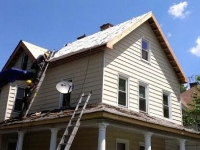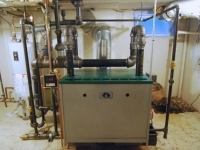Evidence of Catenary for overhaed power on PATH tracks
Are you talking about the PATH tracks just east of Newark Penn Station through Harrison Station and going further east until PATH splits off from the Northeast Corridor tracks? These may not have always been operated by PATH. Harrison Station looks an awful lot like all of the other NJ Transit, formerly CONRAIL stations along the Northeast Corridor. Just my guess but I wonder if PATH always extended all the way to Newark or if it took over those outer tracks later on.
The Harrison Station was built in the late thirties when the tracks were re-aligned to bring the trains into Newark Penn. The system at that point runs on the old Pennsylvania Rail Road main line, and the cantenary towers you see are Pennsy's. The PATH is a standard gauge railroad and can run on regular railroad tracks (although the cars would need a locomotive if there is no third rail).
How could I not open a thread with the word "catenary" in the title? Thanks for the shout out, @kthnry, but shocking as it seems, I've been too busy to write MOL essays.
@max_weisnfeld, you're absolutely correct. But naturally there's so much more to the history.
What's now the PATH was built as the Hudson & Manhattan Railroad, with Teddy Roosevelt starting the first train by telegraph on February 25, 1908, from Hoboken to 19th St Manhattan. Attempts to build that tunnel date back to 1874. The Hudson County waterfront hosted railroad terminals from Hoboken to the what's now the southern end of Liberty State Park, all relying on ferries. The H&M was built to connect the three busiest to Manhattan, and then connect Newark to those locations.
The Pennsylvania RR terminated at Exchange Place until Pennsylvania Station opened in 1910. The Pennsy planned on closing that station, and needed a way for travelers to get to Lower Manhattan. They joined as partners with the H&M, which used their former mainline from Exchange Place to Newark. Columbus Drive used to be Railroad Ave., featuring an enormous viaduct carrying the Pennsy, and the H&M below. Things turned out different, with Exchange hanging on until 1963. The H&M made it Newark in 1911, with a terminal on Park Place in Newark. A station was built to change from midtown bound trains to the H&M for Lower Manhattan, and switch from steam to electric engines, called Manhattan Transfer.
The first area electrification on the Pennsy was for the New York Extension, which initially used third rail. After the New Haven proved overhead catenary practical over long distances between 1907 and 1914, many others, Pennsy included, went that route. They ultimately had the most extensive electrified territory in the US, most of it done in the early 30's with WPA help.
The old mainline from Manhattan Transfer to Exchange was electrified. When the current Newark Penn Station opened in 1935, the H&M moved from Park Place to the new station. The former Pennsy Harrison station became the H&M station, and their tracks didn't get catenary. Catenary was extended to New York, and Manhattan Transfer closed. PATH is a heavy rail (subway) system, which almost always use third rail.
Best sites and maps to chew on...
http://www.hudsoncity.net/tubesenglish/
http://www.jclandmarks.org/history-hmrr.shtml
http://www.tmk.com/hm_gallery/
http://www.columbia.edu/cu/lweb/digital/collections/cul/texts/ldpd_6282382_000/pages/ldpd_6282382_000_00000085.html
http://en.wikipedia.org/wiki/Passaic_and_Harsimus_Line
http://books.google.com/books?id=XgJ6waiti94C&lpg=PP1&pg=PP1#v=onepage&q&f=false
The H&M steadily lost passengers and spent the 50's in bankruptcy. As the price for approving the World Trade Center, NJ forced the PA to take over the H&M, becoming the Port Authority Trans-Hudson on September 1, 1962.
For Sale
Garage Sales
-
HUGE Rummage sale to benefit the Bloomfield High School Robotics Team Sale Date: Apr 27, 2024
More info
Sponsored Business
Promote your business here - Businesses get highlighted throughout the site and you can add a deal.





















Travelling on the MidtownDirect I see remains of of an overhead electrical power on the PATH tracks. I have never found an explanation of why these exist or an historical account that there was ever an operating catenary system on the PATH tracks. Does anyone have any answers?